How to Care for Indoor Herbs: Tips and Tricks

Choosing the Right Herbs for Your Indoor Garden
When starting your indoor herb garden, it's essential to choose herbs that thrive indoors. Popular choices include basil, mint, and parsley, as they adapt well to indoor conditions. Consider your cooking habits; selecting herbs you frequently use can enhance your culinary experiences.
Herbs are the friendliest plants. They are easy to grow, easy to use, and they can transform your meals into something special.
Additionally, think about the space you have available. Some herbs, like chives and thyme, are compact and perfect for small areas, while others may require more space to grow. Understanding the growth habits of different herbs can help you make informed decisions.
Ultimately, starting with a few easy-to-grow herbs will boost your confidence and enjoyment. As you become more experienced, you can experiment with a wider variety of herbs and expand your indoor garden.
Optimal Lighting Conditions for Indoor Herbs
Light is crucial for the healthy growth of indoor herbs. Most herbs require at least 6-8 hours of bright, indirect sunlight each day to thrive. A south-facing window is often the best spot, but if natural light is insufficient, consider using grow lights.

When placing your herbs, be mindful of their specific light needs. For example, basil loves bright light, while parsley prefers a bit of shade. Adjusting their positions based on these preferences can lead to healthier plants and more flavorful herbs.
Select Suitable Indoor Herbs
Choose herbs like basil, mint, and parsley that thrive indoors and align with your cooking habits.
Remember, too much direct sunlight can scorch delicate leaves, so finding that sweet spot is key. Monitoring your herbs regularly will help you determine if they need more or less light, ensuring they stay vibrant and productive.
Watering Techniques for Healthy Indoor Herbs
Watering indoor herbs can be tricky, as overwatering is one of the most common mistakes. To prevent this, ensure your pots have drainage holes, allowing excess water to escape. A good rule of thumb is to water when the top inch of soil feels dry.
Gardening is the purest of human pleasures.
It's also important to consider the specific needs of each herb. Some herbs, like rosemary, prefer drier conditions, while others, such as basil, thrive in consistently moist soil. Tailoring your watering schedule to match each plant's needs will promote robust growth.
Lastly, water your herbs thoroughly until you see it draining from the bottom of the pot. This ensures that the roots are well-hydrated, leading to healthier plants with vibrant leaves and a bountiful harvest.
Choosing the Right Soil for Indoor Herbs
The type of soil you use plays a significant role in the success of your indoor herbs. Opt for a well-draining potting mix that retains some moisture while allowing excess water to escape. This balance is vital for preventing root rot and promoting healthy growth.
You might also consider creating your own soil mix by combining potting soil with perlite or sand. This mix provides aeration and improves drainage, which is especially beneficial for herbs that are prone to overwatering.
Understand Light and Water Needs
Ensure your herbs receive 6-8 hours of bright, indirect sunlight and tailor your watering based on each herb's specific requirements.
Don't forget to refresh your soil every couple of years, as nutrients can deplete over time. Adding organic compost can help replenish essential minerals, ensuring your herbs continue to thrive and produce flavorful leaves.
Fertilizing Indoor Herbs for Optimal Growth
Herbs need nutrients to grow strong and flavorful, so fertilizing is an essential part of their care. Use a balanced, water-soluble fertilizer every 4-6 weeks during the growing season to provide the necessary nutrients. Be sure to follow the package instructions to avoid over-fertilizing.
While herbs don’t require as much fertilizer as some other plants, they do benefit from a little extra boost during their peak growing seasons. Look for organic options, like fish emulsion or seaweed extract, which can provide a more natural approach to feeding your plants.
Keep in mind that too much fertilizer can lead to overly lush growth with less flavor. A little goes a long way, so monitor your herbs and adjust your fertilization routine based on their growth and health.
Pest Management for Indoor Herbs
Even indoors, herbs can attract pests like aphids, spider mites, and whiteflies. Regularly inspect your plants for any signs of insect activity, such as holes in leaves or a sticky residue on the plant. Catching infestations early can make them easier to manage.
If you notice pests, a gentle spray of water can often dislodge them. For more stubborn infestations, consider using insecticidal soap or neem oil, which are both effective and safe options for indoor use. Always test a small area first to ensure your herbs don’t react negatively.
Regular Harvesting Boosts Growth
Frequent harvesting and proper pruning encourage new growth and enhance the flavor of your indoor herbs.
Additionally, keeping your growing area clean can help prevent pests from taking hold. Remove any dead leaves and debris, as these can attract unwanted visitors and create a less hospitable environment for your herbs.
Harvesting and Pruning Indoor Herbs for Best Flavor
Harvesting your herbs regularly not only enhances their flavor but also encourages new growth. Use clean scissors to snip off leaves, always taking care to leave enough foliage for the plant to continue thriving. This practice keeps your herbs bushy and productive.
When pruning, aim to remove the top third of the plant to promote fuller growth and prevent legginess. Many herbs, such as basil and mint, respond well to this technique, resulting in a more robust plant with a better flavor profile.

Finally, remember that fresh herbs are most flavorful before they flower, so keep an eye on your plants. If you notice flower buds forming, consider harvesting more frequently to enjoy the best taste from your indoor herbs.